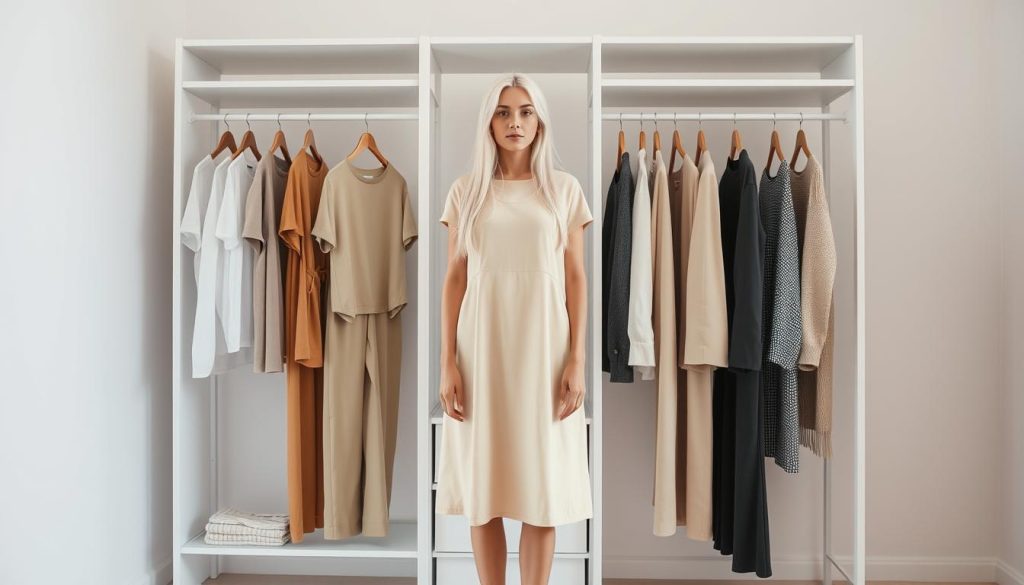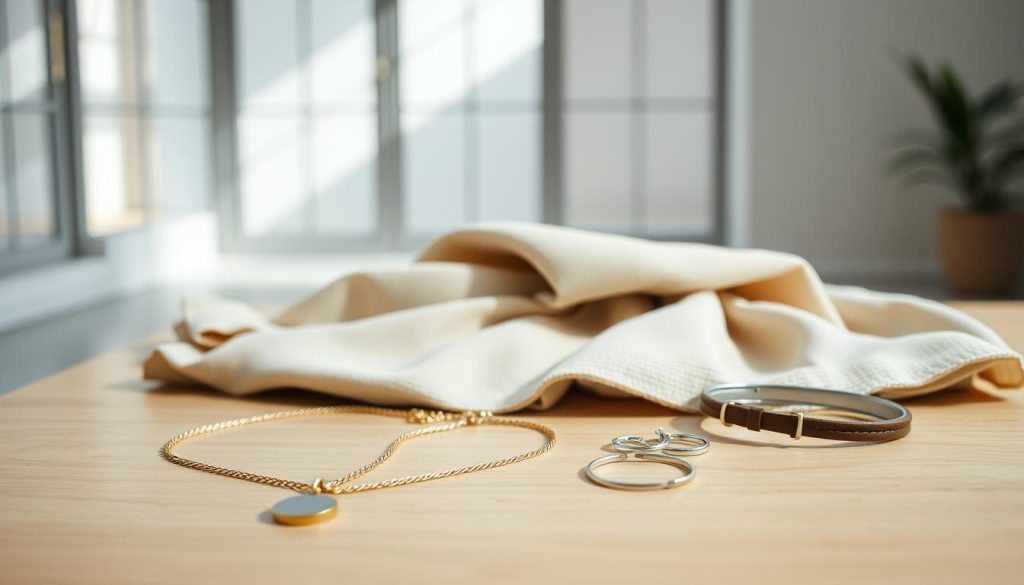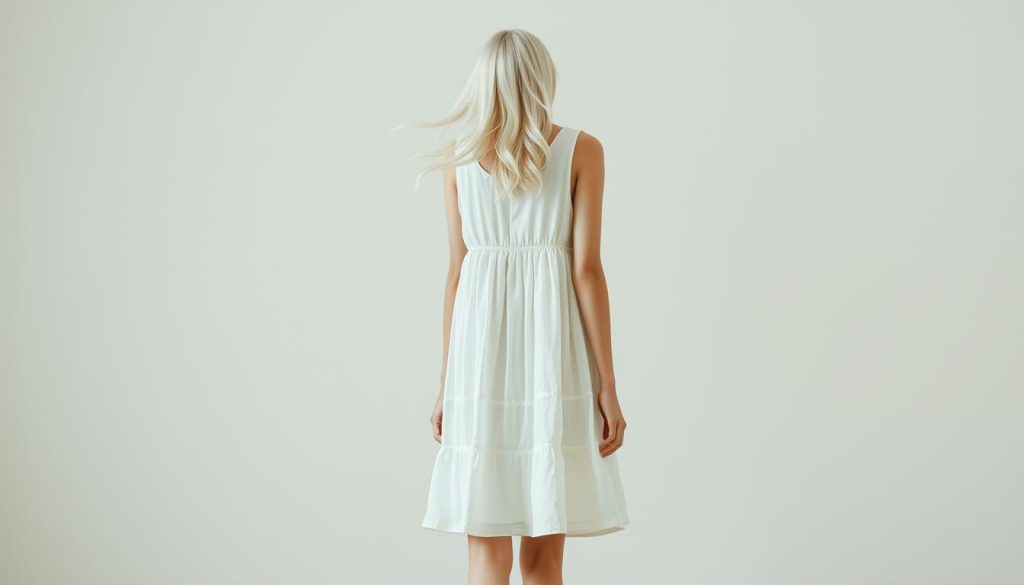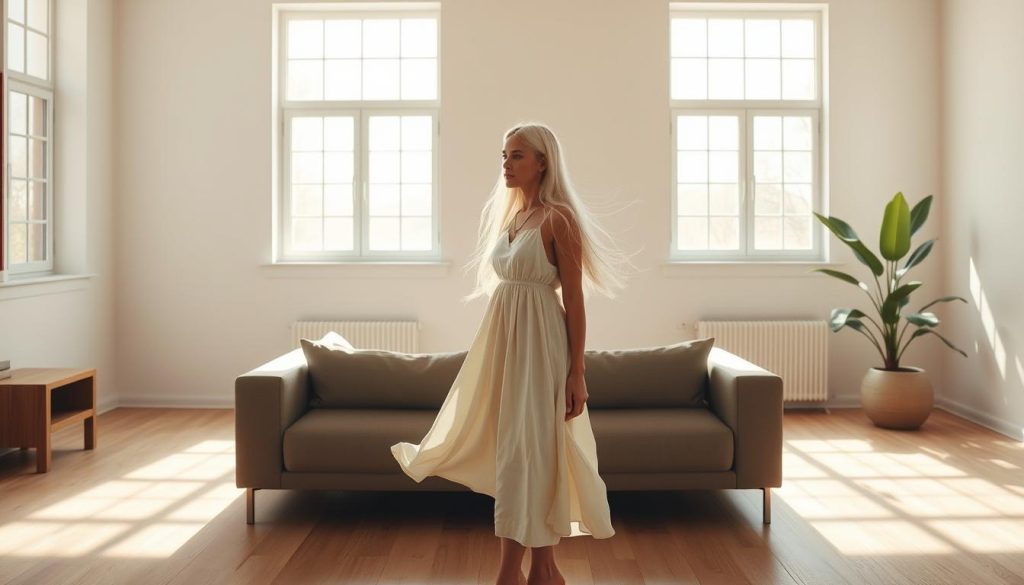Ready to make getting dressed your favorite part of the morning? I’ll show you how a clear, joyful approach can turn daily outfit stress into ease! This guide is for anyone who wants a smarter wardrobe without losing personality.
Minimalist clothing prizes simplicity, function, and pieces that last. You don’t need a uniform or only black and white to get this right. I’ll help you pick durable clothes that work hard and cut waste for the environment.
You’ll learn practical steps to edit what you own, pick better fabrics, and build outfit formulas that save time. Expect small, actionable moves that make getting dressed fast and fun. Let’s build a closet that supports your life and lets your personal style shine!
Key Takeaways
- Build a streamlined wardrobe that makes getting dressed joyful.
- Choose durable pieces to reduce waste and help the environment.
- See minimalism as a mindset that frees your personal style.
- Learn outfit formulas that save time without losing flair.
- Focus on quality, fit, and care so favorites last longer.
What Minimalism Fashion Really Means Today
A clear wardrobe starts with a mindset, not a shopping list. You choose fewer pieces with intention. That choice frees your mornings and sharpens your style!
Mindset versus aesthetic: less stuff, more intention
Think of the approach as habits, not a look. You pick clothing that fits your life and flatters your shape.
Small shifts—better silhouettes and colors that suit you—help you wear the same outfits without boredom.
Why “simple” doesn’t mean boring
Simple outfits gain interest through texture, proportion, and one standout brand detail like a polished loafer or tote.
Neutral colors mix easily, while an accent hue keeps your presence lively. Your movement and confidence do the rest!
- Focus: own fewer items you love and repeat them.
- Mix: neutral colors plus one accent make outfits pop.
- Elevate: add texture, fit, and one strong brand detail.
| Goal | How | Result |
|---|---|---|
| Clarity | Choose signature pieces | Faster mornings |
| Variety | Use neutrals + accents | Fresh looks from few items |
| Longevity | Pick durable fabrics | Less waste, more wear |
From Chanel’s LBD to The Row: A Brief History and Philosophy
Some of the most influential looks began with a simple, confident idea. In the 1920s, Coco Chanel gave us the little black dress and the guiding line:
“Simplicity is the keynote of all true elegance.”
That maxim still shapes how you and I think about clothes today! Over the years, labels like The Row, Calvin Klein, Jil Sander, and Phoebe Philo-era Celine refined that approach.
The rise of understated brands shows how quiet design wins. A crisp white shirt, navy cashmere, classic black trousers, and a vintage pair of jeans become the backbone of smart dressing.
“Simplicity is the keynote of all true elegance” in context
Here’s why this way endures: clean designs read modern and confident. They let silhouette, texture, and proportion do the talking—not logos.
The rise of understated labels and the power of the perfect basics
- Craft over clutter: fit and drape matter more than trend cycles.
- Enduring elements: a well-cut shirt or trousers last for years.
- Curate, don’t accumulate: fewer pieces, stronger outfits.
Minimalism Fashion
A smart wardrobe begins with choices that match your life, shape, and skin tone! I want you to feel excited about the clothes you reach for each morning.
Keep it practical and personal. Pick pieces that flatter your frame and the colors that make your skin glow. No magic number matters; an 18-piece test can help, but it’s not a rule.
Track what you wear across the year. Note the items you love and use them to guide future buys. That simple habit saves time and reduces clutter.
- Clear: choose what you wear all the time and mix easily.
- Flexible: your wardrobe should fit your life, not a number.
- Balanced: comfort and polish, so clothes support your day.
| Focus | Action | Result |
|---|---|---|
| Flatter | Pick shapes for your body | Better fit, more wear |
| Color | Limit to 4–5 hues + neutrals | Cohesive palette |
| Use | Track wear for a year | Smarter buys, less waste |
Bottom line: this approach helps people spend less energy on outfits and more on living! Your closet becomes calm, practical, and unmistakably you.
Define Your Personal Style: Color, Body, and Everyday Life
Pick four to five go-to hues and let those colors guide every outfit choice you make. This simple rule makes shopping and dressing faster and more joyful!
Color first
Start with a palette that flatters your skin. For example, a true summer leans to cool, muted tones like soft gray-blues and gray-violets.
Choose 4–5 colors you love, plus neutral colors you can wear on repeat. This keeps your clothes cohesive across seasons.
Match shapes to your body
Use silhouette guidance to highlight your best features. Try Kibbe as a helpful tool—
“Soft Classics glow in clean lines with gentle waist definition.”
That means balanced pieces with subtle structure. Tailored shirts and fitted trousers often work well here.
Dress for your real week
Note how you spend most days—WFH, office, or a mix. Build go-to uniforms with shirts and layers that suit those routines.
- Work-from-home: comfy knits with a smart top layer.
- Office days: crisp shirts and tailored trousers.
- Off-duty: jeans, a good tee, and a versatile jacket.
| Focus | Action | Why it matters |
|---|---|---|
| Color | Pick 4–5 hues + neutrals | Faster decisions and cohesive outfits |
| Body | Choose silhouettes by Kibbe or shape | Clothes flatter and feel natural |
| Routine | Build uniforms for your week | Wearability equals less stress |
Bottom line: keep your personal style front and center. With the right colors, shapes, and a real-week plan, your closet will work harder for you every day!
Edit the Closet: A Practical, Sustainable Declutter
A smart edit turns chaos into calm—one pile at a time. Pull everything out of the closet and get clear fast. Small, focused moves save you time and mental energy!
Love / No / Maybe piles: try-on, photograph, decide
Sort items into three piles: Love, No, and Maybe. Try on Maybe clothes and take photos in good light. That simple step helps you decide without guessing.
Tailor first: small changes for a major upgrade
Before you discard, consider a quick alteration. A hem or nip can turn a “meh” item into a favorite. Keep a tiny repair kit so fixes happen in the moment!
Responsible exits: local thrift, swaps, gifting, and recycling
Gift or swap with friends so pieces are re-worn. Choose local thrift stores and community drives to protect the environment. Avoid random bins—check first with loved ones.
- Quick order: pull, sort, try, decide—clarity beats clutter.
- Track what you wear; if it’s unused, let it go with gratitude.
- Adopt a one-in, one-out habit to keep your wardrobe balanced.
Build a Minimalist Wardrobe Capsule
Choose a tight core of pieces that do heavy lifting for your whole wardrobe. Start with reliable foundations and add only what truly earns a spot. This keeps mornings simple and joyful!

Wardrobe foundations: shirts, jeans, trousers, blazers, and knits
Define your base: crisp white button-downs, a navy cashmere sweater, classic black trousers, and trusted vintage jeans. These staples are the backbone of a capsule and work across seasons.
Choose versatile pieces in durable fabrics and timeless designs
Pick fabrics that last—wool, cotton, linen. Favor clean designs that mix easily. That way each item supports multiple outfits with minimal fuss.
Right number, right for you: beyond strict piece counts
There’s no magic number. The right number is what you wear and enjoy. Start tight, then add thoughtfully so your clothes stay lean and powerful.
Outfit formulas that make getting dressed effortless
- Blazer + tee + trousers + loafers = instant polish.
- Knit + jeans + trench + tote = relaxed, pulled-together.
- Make sure each new piece pairs with at least three outfits before it joins the team.
| Core Item | Why | Example |
|---|---|---|
| Shirts | Versatile and layerable | White button-down |
| Knits | Comfort + warmth | Navy cashmere |
| Jeans & Trousers | Casual to formal | Vintage jeans / black trousers |
The Power of Neutrals—and Your Personal Palette
A smart palette starts with dependable hues that play well together. Build your base from classic neutrals so choices feel fast and confident every morning!
Classic building blocks
Experts recommend anchors like black, navy, gray, brown, ivory, and oatmeal. These shades make mixing easy and keep your wardrobe cohesive.
Your version of “neutral”
Pick one or two personal hues that behave like basics. French blue or a deep wine can act as a neutral if you reach for them often. This keeps your style lively without extra effort.
- Keep the palette tight so outfits form in seconds.
- Use texture—ribbed knits, brushed wool, matte leather—for depth without loud prints.
- Accessories add interest and polish without breaking simplicity.
When you choose the color that brightens your face, you’ll always pick the right piece. That small habit makes a minimalist aesthetic feel personal and joyful. Treat your palette as a signature—it’s the easiest way to a reliable minimalist outfit every day!
Fabrics, Fit, and Quality: What to Look For
Smart clothing starts with materials that stand up to daily life and still look fresh! Choose pieces that feel good now and keep giving value for years.
Materials that last
Prioritize organic cotton and natural fibers. They breathe, wash well, and often wear better over time. Look for clear fabric labels and sturdy stitching.
Check seams, hems, and weight. Solid construction keeps clothing in rotation for years and reduces waste.
Fit checks: silhouette, drape, and proportion
Fit is everything. Dial in silhouette so each piece flatters your body with ease. Try clothes on and move—sit, reach, walk—to see how they perform.
When in doubt, tailor! A small adjustment can make a favorite item feel brand new and extend its life.
- Choose pieces that resist pilling and hold shape after washing.
- Favor brands that disclose materials and construction details.
- One quality item you wear weekly beats three that fall apart fast.
| What to check | Why it matters | Quick test |
|---|---|---|
| Fabric content | Durability & comfort | Read the label |
| Stitching | Longevity | Inspect seams |
| Fit | Wearability | Move in it |
Goal: Build a core of well-made pieces that fit beautifully and go the distance. Track the materials you love so future buys are easier and smarter!
Style It Smart: Accessories, Texture, and Re-mixing
Accessories are the secret punctuation that turn basics into statements.
Make jewelry, a staple bag, or shoes your signature! A vintage ring or sleek watch can anchor an outfit and show your style without noise. Sometimes choosing no jewelry is the boldest move.

Signature accessories: jewelry, staple bags, and shoes
Pick one strong element each day. Pearls, a leather tote, or a polished loafer define your vibe quickly. A consistent piece becomes part of your personal brand and saves decision time.
Texture play: elevating basics with subtle contrast
Mix suede boots with a smooth belt or a ribbed knit with matte leather. Texture adds quiet drama and lifts simple clothes into a refined style.
Re-style your go-tos: fresh ways to pair the same pieces
- Swap shoes or change the bag to refresh looks.
- Rotate at least one element each repeat to keep outfits new.
- Photograph combos you love for quick inspiration later.
“Small tweaks, big payoff.”
Sustainable Minimalism in Practice
You can rethink how you acquire clothes so each buy earns its place. This approach slows shopping and boosts value for the environment and your daily routine!
Rent, swap, borrow, and mend
Renting or borrowing lets you enjoy variety without clutter. Swaps with friends refresh your closet for free. Mending extends life and costs little.
Services like Sojo offer mends from £10—fast and affordable. These ways save money and protect the environment.
Plan five thoughtful purchases a year
Try a five-items-a-year rule. Buy less, choose better, and make each product work harder in outfits.
Audit what you own first. Then prioritize alterations or remakes—turn a dress into a top to unlock fresh mileage.
Alterations, repair credits, and durability guarantees
Big brands now help. Net-a-Porter, Ralph Lauren, and Mulberry offer alteration services, recycling credits, and guarantees.
Tap those options! A small alteration can transform fit and extend wear for years.
Trendless design and policy momentum
Lean into trendless clothing—timeless staples last longer and feel better over time. The proposed US Fashion Act would push brands to own product life cycles and reward durability.
- Embrace circular habits—rent, swap, borrow, mend.
- Plan purchases to buy with intention each year.
- Use repair services and take brands’ credits and guarantees.
- Block small pockets of time to care for and store pieces well.
Result: A minimalist wardrobe plus sustainable habits equals less waste and more joy per wear. You’ll save time, protect the environment, and look great doing it!
Minimalist Clothing Brands Worth Knowing
Great brands make simple clothes feel luxurious and lasting! I’ll point you toward companies that choose organic cotton, natural fibers, fair pay, and low-plastic packaging so your buys do more good.
Brands prioritizing natural materials and ethical production
Look for brands that publish supply-chain details and use organic cotton, linen, or wool. These labels often partner with repair services and offer alteration credits to extend the life of your shirts and knits.
Capsule-ready essentials for women and men
Choose products that pair easily: shirts, knits, tailored trousers, and a durable coat. Favor colors that mix well so every piece multiplies outfit options for both women and men.
Recycling programs, climate-neutral pledges, and B Corp leaders
- Repair, take-back, and recycling programs show a brand backs circular clothing.
- Climate Neutral certification and B Corp status mean deeper environmental and social commitment.
- Charity givebacks and low-plastic design are signs the brand values impact over hype.
Buy less, choose better, and pick brands that help items last. That’s the quickest route to a capsule you actually love wearing!
Conclusion
A considered closet turns daily dressing into a quick, joyful ritual. ,
You’ve got this! Build a wardrobe that feels like you and supports your life every day. Focus on fewer, better clothes that mix easily so getting dressed takes less time and energy.
Keep your closet edited. Tighten your color story and pick silhouettes that flatter your body. Trust timeless picks—a great blazer or a favorite pair jeans will serve you for years.
Practice small habits: mend, tailor, care. Let your personal style lead the way. When in doubt, return to palette, fit, and function—they never steer you wrong!
Dress smarter, not harder! Enjoy the freedom that follows, every day.
Discover the transformative power of authentic healing crystals from Conscious Items, designed to align your spirit and connect you with nature’s energy. With over 500,000 satisfied customers and a 4.9/5 Trust pilot rating, don’t miss out on finding your perfect crystal—shop now before these unique treasures are gone! Take their exclusive crystal quiz today at Conscious Items to uncover your spiritual muse.
If you liked reading this article you will love this article Crystal Healing Properties: Unlock White Crystal Power!
Elevate your spiritual journey with Conscious Items’ genuine gemstones, trusted by thousands and backed by a 30-day money-back guarantee. Don’t let these powerful crystals pass you by—stocks are limited, and the perfect one for you is waiting! Visit Conscious Items now to find your crystal match before it’s too late.
If you liked reading this article you will love this article Minimalism Checklist: The ONLY Checklist you need
Morganite Crystal Healing Properties
Habits of Healthy Relationships: 10 Keys to Lasting Love: The Ultimate Love Stone for Heart Healing




